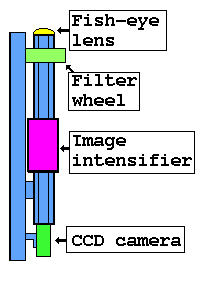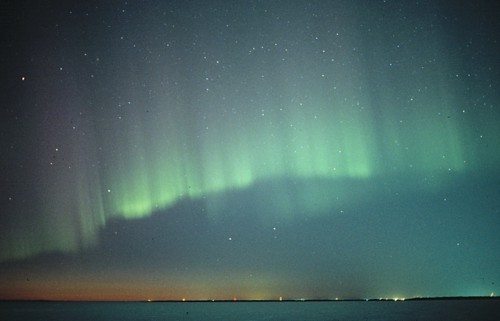Technical description of the intensified all-sky imagers
 The all-sky imagers that are used in the intensified all-sky cameras
are manufactured by KeoConsultants. Each imager has
telecentric and non-vignetting optics, and the field of view of the
fish-eye lens is 180 degrees.
The all-sky imagers that are used in the intensified all-sky cameras
are manufactured by KeoConsultants. Each imager has
telecentric and non-vignetting optics, and the field of view of the
fish-eye lens is 180 degrees. The filter wheel have seven slots for narrow bandwidth interference filters. In normal operation one filter holder is empty to allow acquiring non-filtered, star images, which are used for geometric calibration. Every station has filters for green, blue, and red line emission.
The faint images are intensified before the final image is acquired by the CCD camera (B&W) and digitised by the frame grabber card of the station computer. This intensification allows shorter exposure times with less expensive CCD cameras, and typically an exposure takes 500ms. A standard imaging sequence includes one green line image every 20 sec, and one blue and red line image every 60 sec. Non-filtered images are taken at least once an hour. All images are stored in 8-bit JPG format with 512x512 pixel resolution.
Photographs of the cameras.
The operation of the imager is controlled by the station computer of
the all-sky camera station.
Technical specifications
| ITEM | DESCRIPTION |
| Fish-eye lens | Canon 15mm/F2.8 |
| Additional optics | Telecentric lens elements |
| Filter wheel | 5-position filter wheel for 2" filters |
| Filters | Interference filters, wavelengths 557.7nm, 427.8nm, and 630.0nm (BW 2.0nm) |
| Intensifier lens | Canon 85mm/F1.2 |
| Image intensifier | Varo 25mm MCP Gen II Image Intensifier model 3603 |
| Reimaging optics | Canon 100mm/F2 |
| CCD camera lens | Fujinon 25mm/F0.85 |
| CCD camera | Pulnix 765E, 756(H)x581(V) |
More information: Kirsti Kauristie
e-mail: firstname.lastname@fmi.fi

